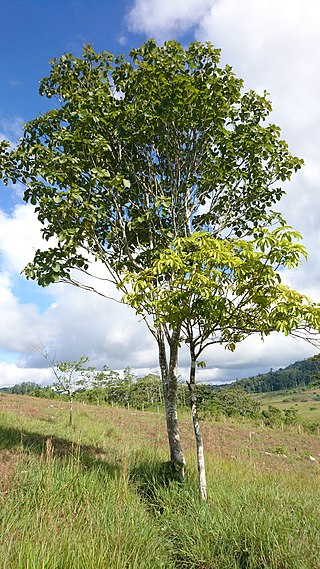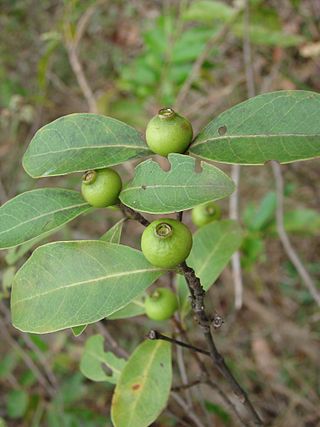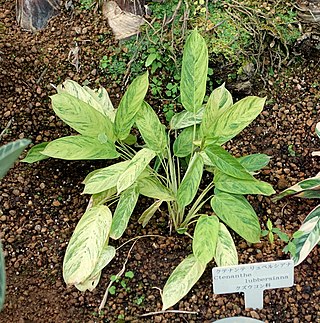
Wittmackia is a genus of flowering plants in the family Bromeliaceae.

Bertiera is a genus of flowering plants in the family Rubiaceae. It comprises 57 species with most known from tropical Africa, five known from various Indian Ocean islands and five found in the tropics of the Americas.

Rustia is a genus of flowering plants in the family Rubiaceae. There are 17 species distributed in tropical Central and South America. They are shrubs and trees up to 15 metres (49 ft) tall.

Simira is a genus of plants in the family Rubiaceae. The genus was first published by French pharmacist and botanist Jean Baptiste Christophore Fusée Aublet in Hist. Pl. Guiane vol.1 on page 170 in 1775.

Alibertia patinoi, commonly known as borojó, is a small (2-5m), dioecious tropical rainforest tree, one of the few edible fruit bearing species in the Rubiaceae family. Borojó, native to the world's wettest lowlands, grows in the Chocó Department of northwestern Colombia and in the Esmeraldas Province of northwestern Ecuador.
Remijia is a genus of flowering plants in the family Rubiaceae. Within the family, it is a member of the subfamily Cinchonoideae and the tribe Cinchoneae.

Duroia is a genus of flowering plants in the family Rubiaceae. The genus is found from Costa Rica to tropical South America.

Amaioua is a genus of flowering plants in the family Rubiaceae. It was first described by Jean Baptiste Aublet in 1775. The genus is native to tropical America from southern Mexico to Brazil, including Cuba and Trinidad.

Retiniphyllum is a genus of flowering plants in the family Rubiaceae and contains 20 species. It is the only genus in the tribe Retiniphylleae. The representatives are shrubs or small trees that grow in white sand soils in tropical South America. They are mainly distributed in the Guayana Region (Venezuela) but also occur in the Amazon Basin, the eastern Andes and central and eastern Brasil.
Agouticarpa is a genus of flowering plants in the family Rubiaceae. It was described by Claes Persson in 2003. The genus is found from Costa Rica to Bolivia.

Chimarrhis is a genus of flowering plants in the family Rubiaceae. It has 15 recognized species, native to Central America, South America and the West Indies.

Cordiera is a genus of flowering plants in the family Rubiaceae. The genus is found in central and southern tropical America.

Coussarea is a genus of flowering plants in the family Rubiaceae. The genus is found from southern Mexico to tropical America.

Ferdinandusa is a genus of flowering plants in the family Rubiaceae, native to the American tropics.
Cordiereae is a tribe of flowering plants in the family Rubiaceae and contains 124 species in 12 genera. Its representatives are found in central and southern tropical America.
Sphinctanthus is a genus of flowering plants in the family Rubiaceae, native to tropical South America. It is in a clade with Rosenbergiodendron and Tocoyena.

Ctenanthe lubbersiana, called the bamburanta, is a species of flowering plant in the genus Ctenanthe, native to Brazil. It has gained the Royal Horticultural Society's Award of Garden Merit as a subtropical hothouse ornamental.
Plenckia is a genus of flowering plants belonging to the family Celastraceae.

Benjaminia is a monotypic genus of flowering plants belonging to the family Plantaginaceae. It only contains one known species, Benjaminia reflexa(Benth.) D'Arcy.














